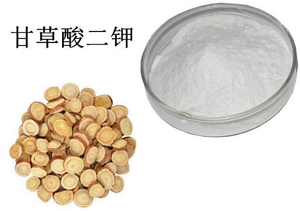Dipotassium Glycyrrhizate (DPG) is an active ingredient extracted from the roots of the leguminous plant licorice (Glycyrrhizauralensis Fisch.). Generally speaking, licorice is mainly divided into three categories: licorice, licorice, and licorice (also known as licorice).

Efficacy in cosmetics
Anti-inflammatory effect
Anti-allergy effect
Regulating immune function
Mechanism of action
1. Regulation of immune function
Dipotassium glycyrrhizinate has mineralocorticoid-like effects – sodium retention and potassium excretion and glucocorticoid-like effects – sugar metabolism, but there are no side effects with long-term use.
Direct effect: It is generally believed that the chemical structure of glycyrrhetinic acid in dipotassium glycyrrhizinate is similar to that of adrenocortical hormone (Cortin). It affects ion channels and activates them by acting on the hormone receptor (Receptor) on the cell membrane. Or inhibit enzyme activity, regulate substance metabolism, and regulate the excitability of cholinergic nerves. As a result, the permeability of capillary walls and cell membranes is reduced, inflammatory exudation is reduced, and the formation and release of histamine and other toxic substances are inhibited, thereby achieving a good anti-inflammatory effect.
Indirect effect: That is, the glycyrrhetinic acid in dipotassium glycyrrhizinate inhibits the destruction of adrenocortical hormones in the body, thereby increasing its content in the blood, thereby enhancing the body’s resistance to inflammation.
2. Anti-allergic effect
Glycyrrhizic acid and its potassium salt have good anti-allergic effects, inhibiting histamine production and skin redness and itchiness, and especially have obvious protective effects against certain anaphylactic shocks. The basic unit between the stimulus that causes itching and the impulse that occurs in free nerve endings is a physiologically active mediator. Histamine is the material basis of itching. Any factors that stimulate mast cells can degranulate the mast cells and release histamine, thus causing itching. Therefore, antihistamines and drugs that stabilize mast cells and reduce histamine release can be used clinically to treat common itching. As a common complication of skin sensitivity, itching has main allergens and pathways of action similar to allergic reactions. Experiments have proven that , Dipotassium glycyrrhizinate inhibits the occurrence of type I hypersensitivity reactions and can largely reduce the onset of itching.
3. Regulate immune function
Security
1. No irritation to eyes and skin, non-toxic, no side effects;
Human skin closed patch experiments show that dipotassium glycyrrhizinate has good skin tolerance without any irritation or sensitization. At the same time, skin test experiments show that dipotassium glycyrrhizinate has mineralocorticosterol-like effects and glucocorticoid-like effects. However, within the recommended dosage, long-term use has not produced physical or psychological dependence, nor has it had any side effects.
2. Biodegradable;
3. It can be used as a sweetener or for medicinal purposes.
Usability: Usage: 0.10-1.0%
Easy to use
Emulsification system: add water phase directly, resistant to high temperature;
Gel system: add directly (ionic, has slight viscosity reducing effect);
Cleaning system: Add directly.

 微信扫一扫打赏
微信扫一扫打赏

